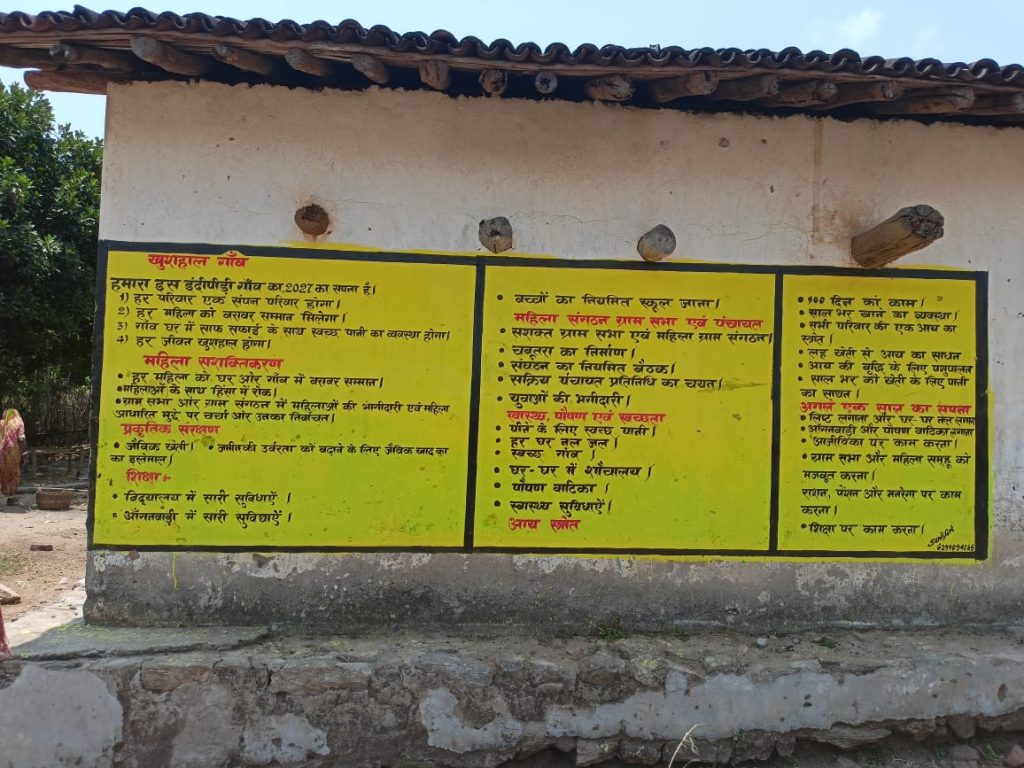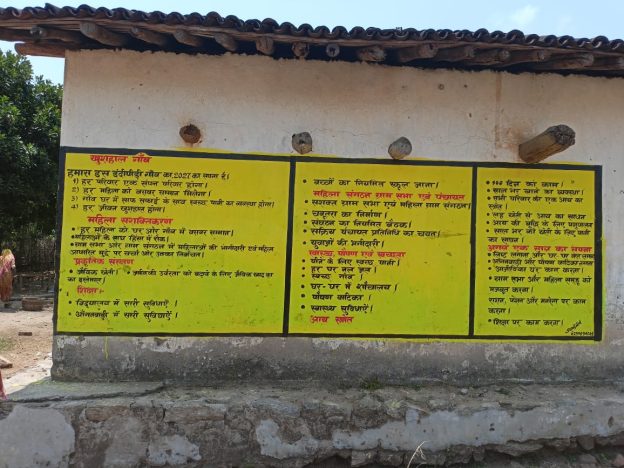Community knowledge, connection and stewardship of a place go hand-in-hand. Listening and building connection is critical not just for the place but also for a sustainable planet

Villagers in Mosanga village in Jharkhand’s Khunti district, document their needs and aspirations as part of a village visioning exercise. Photo: PRADAN
I had never heard of a fasal chakra.
Nor a village engineer. Neither about halma, swaraj shala and gram swabhiman diwar. And the most counter-intuitive and rational-defying thing I learnt was that there are communities in India who have successfully relied on coconut-sensing (and not hydrology engineers) to find suitable spots to dig wells in! There’s a tendency to brand such concepts and notions as unscientific, absurd, and pejoratively, jugaad. And yet these simple tools and methods, often waiting to be investigated by science, go a long way in bringing people together as they navigate and conquer the challenges of their places – be it to locate appropriate spots to dig wells in or to understand season-specific cropping or to give voice to the dreams for their villages.
Villages, or the rural, are largely perceived to be places of self-sufficiency, and therefore presumed to be available for production and extraction to meet the needs of the urban scape. This is a myth. Rural India today is not only far from being self-sufficient, but is also on the brink of collapse – evident by the sentiments of truckloads of farmers who had stopped on the borders of the national capital this Valentine’s Day. On the same day, far from the voices of protest, we heard from community organisations about what ailed the rural – deteriorating farms, irregular markets, an ever-mounting problem of waste, disillusioned and unemployed youth, increased migration, decreased dignity, eroding connections and loss of local problem-solving muscle.
Grassroots, non-profit and funding organisations often struggle to navigate the rabbit hole of such interconnected challenges. Reliance on projects and predetermined solutions more often leads to piecemeal fixes and rarely leads to holistic well-being of the people and the place. For instance, advocating solar-powered irrigation to boost food production and cut fossil fuel emissions is a go-to solution for funders, administrators and grassroots organisations. This emphasis on solar-powered irrigation has exacerbated the groundwater crisis, putting a question mark on the well-being of the place. If we are to become the people our places need us to be, then it’s important to listen and learn from the novel and non-mainstream approaches. A session with an eclectic group of grassroots organisations last month provided an opportunity for such reflection. These are some of the things we learnt:
Learn, not prescribe; proactively look for strengths; altruism for the long haul
Strive to build model processes, and not a model village, shared Nitin of Shivganga, an organisation that works in Jhabua, western Madhya Pradesh. Building a model village might be good for one village, but it alienates the neighbouring villages, and is counterproductive for social and natural resource outcomes. One of their key tenets as part of model process building is to spend time among residents with the intention to learn (not prescribe, teach or impose), ask about the challenges and the dreams/aspirations of the village (as opposed to of the people), and understand in what ways they would like to resolve the challenges. Another tool they rely on is to proactively ask about the strengths and skills of the community to leverage these as well as seek out those individuals who are action-oriented and ever ready to volunteer their time and effort for the larger good. Probing for these led the organisation to revive a traditional practice that had faded out: halma (also referred to in the region as dhaaas, laah, dhasia, notra) is a culturally-embedded practice wherein all the residents of the village come together to aid a person in need – be it to sow/harvest fields or to rebuild a house. Every household in the village volunteers a person, who contributes his/her time and skill. If a household is unable to send a person, then it contributes by cooking meals, offering tools and equipment, etc. Children are encouraged to watch the halma to instill collective pride as well as to build intergenerational memory. A core principle in this approach is that of parmarth or altruism – an engine that never stops and keeps everyone humble and focussed on the long road ahead.
Nature, economics & gain-drain
The natural ecosystem (forest, soil, plants, terrain, temperature, water, etc) is fundamental to a place, shared Diksha of WASSAN. From this, emerges a production system, leading to livelihoods, which then adds up to the creation of an economy. Local facilitators rely on games and maps to ask communities to identify the natural assets, be they farmlands, ponds, forests etc in their region in an attempt to visibilise the gain v/s drain from the ecology and the economy. The communities typically are asked about the health of the local ecology, economy, overall quality of human lives, social harmony, institutions, etc. The fasal chakra – a season-wise chart of crops that were traditionally grown be they cereals, oilseeds, pulses, etc – is a part of this exercise, and helps demonstrate what the village economy is producing, what it is failing to produce and therefore expending money on, and the consequences of such trade-offs. For instance, it emerged that one panchayat in Jharkhand was spending as much as Rs.1.2crore per year on vegetables alone. A single-minded focus on increasing farm incomes not only led to cash crops at the expense of soil and water quality, but it also meant the local economy was poorer by Rs.1.2cr since nobody was growing vegetables to meet the local demand. Such efforts often lead communities to a sense of collective loss, and serve as sparks to take action for the ‘drain’.
Enabling local wisdom and dreams

A girl pens her name and the name of her village on the gram swabhian shapath (pledge). Photo: Goonj
Did people dig wells before the existence of hydrology engineers? How did they know where to dig for water? And does the presence of an engineer guarantee that a newly-dug well will lead to water? Anshu of Goonj posed these questions as he spoke about the value of asking communities what they are rich in (be it knowledge, skills, insights, cultural practices, natural resources, etc) as opposed to what they lack (monetary riches). There is value in local wisdom, resourcefulness and practices, he said, as is evident by the fact that many communities rely on coconuts to ascertain spots to dig wells in. Whether based in superstition or science, Goonj leaves decision-making to the people and sees its role in challenging and supporting the village’s collective sense of pride.
A key principle of this approach is to recognise the inherent dignity of people and places. For instance, why is it that those who give away used clothes are thanked for their giving, but those who receive those very clothes are not acknowledged and thanked for wearing/reusing them? Similarly, most people refer to themselves as ‘poor’ so as to be able to access government subsidies and schemes. They’ve internalised this label to such an extent that they now fear losing out on these benefits.
This is where language has a part to play. Goonj flips the established vocabulary, and ditches the use of words like ‘charity’, ‘donors’, ‘volunteers’, ‘beneficiaries’, ‘poor’, etc. Instead, the emphasis is on valuing people for the skills and strengths they already have. Aids such as the gram swambhiman shapath (pledge) and gram swabhiman diwar (dignity wall) are leveraged to invoke pride and connection to the place.
With contributions from Abhishek Tiwari
(The 2-day session was attended by members from multiple organisations: CEEW, Goonj, Pradan, Round Glass Foundation, Shivganga, Socratus, SSRDP, Vaagdhara, WASSAN


Thank you for sharing such an insightful article! I found your exploration of grassroots approaches to rural challenges in India both enlightening and thought-provoking. The introduction of concepts like fasal chakra, halma, and the role of the village engineer highlights the importance of local knowledge and community-based solutions in addressing complex issues.
It’s fascinating to see how traditional practices, often dismissed as “unscientific,” can offer practical and effective ways to solve modern problems. The example of coconut-sensing for well-digging is particularly striking; it shows that indigenous knowledge systems have significant value that shouldn’t be overlooked or underestimated.
I agree that the perception of rural areas as self-sufficient is a myth. The challenges you’ve outlined—deteriorating farms, irregular markets, and increased migration—are indeed pressing issues that require holistic and sustainable solutions. It’s refreshing to hear about organizations like Shivganga that prioritize learning from communities rather than imposing solutions. This participatory approach not only fosters empowerment but also strengthens social cohesion and resilience.
The insights into the fasal chakra and the economic implications of focusing on cash crops serve as a critical reminder of the interconnectedness of ecological health and local economies. It’s vital for communities to recognize their natural assets and understand the implications of their agricultural practices on both the environment and their livelihoods.
Your call for a shift from prescriptive models to a more process-oriented approach is vital. By embracing the strengths and aspirations of communities, we can cultivate solutions that are more sustainable and culturally relevant. Thank you for highlighting these innovative strategies; they inspire hope for a more equitable and resilient future for rural India. I look forward to seeing how these ideas evolve and take root in various communities!
Such an interesting read! I never realized the connection between coconuts, engineers, and wells. It’s fascinating how coconuts can play such a crucial role in sustainability. At Goodio Eats, we’re always looking for natural ingredients to create delicious and healthy products. Coconuts, with their versatile benefits, are definitely among the many nutritious components we incorporate into our snacks. From energy-boosting trail mixes to fresh, wholesome treats, we believe in bringing nature’s goodness to your plate. Keep up the great work, Rainmatter!